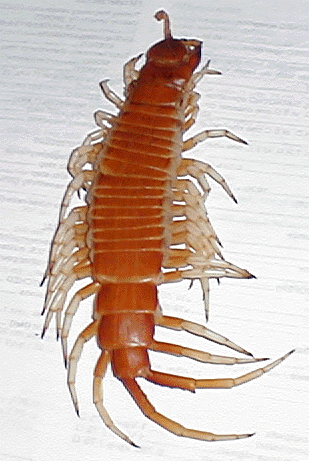Scolopendra Gigantea
Centipedes are growing in popularity among collectors of exotic pets. Giant centipedes are found naturally in tropical and sub-tropical areas of northern South America, Brazil, and Peru. There are about 2,800 species of centipedes, some that have not been classified yet. The Peruvian centipede is a member of the class Chilopoda, the phylum Arthropoda, the order Scolopendra, and probably the species Gigantea. The Peruvian centipede is the world's largest centipede. They are fast and aggressive, as with any Scolopendra centipede. Some of these larger centipedes make spectacular display animals. These spectacular pets can be used to evoke an array of reactions from friends and family. Giant centipedes are extremely venomous and bites from one might be compared it to a viper bite. They kill their prey with their poison jaws which contain venom. The bit is painful to humans and large animals because of this venom. The jaws have a poison gland located on the head that secretes a neurotoxin that allows its prey to remain alive and breathing, but paralyzed. Some people are more sensitive or allergic to this venom, so you should never handle a giant centipede! If a Giant Peruvian Centipede bites your hand, he will probably latch on with his fangs, then wrap around your arm. There is a possibility that your arm will permanently go numb after intense pain. Even common house centipedes have venom, so do not mess with them either.
|
Centipedes breathe by taking in oxygen openings along the sides of their body called spiracles. They are located between the upper and lower chitinous shields and just behind the legs. The air travels through slender tubes called trachae. The trachae filters oxygen into the body by a process called diffusion. They lead into the larger tracheal chambers that branch off to supply the various parts of the body with oxygen. The heart is a chambered dorsal vessel. On the large Scolopendra, like the Peruvian Centipede, spiracles are located at segments 4,6,8,11,13,15,17,19, and 21. The openings are either round, triangular or s-shaped. Unlike insects, the spiracles in a centipede cannot be closed, therefore water loss in centipedes can happen quite quickly and dehydration will occur. Blood flows through a tube, which is located directly under the exoskeleton on its back. The centipede's nervous system consists of a relatively large brain connected with a ventral chain of ganglia, or two nerve cords, stretching the entire length of its body. The Scolopendra's eyes are simple, seeing only shadows of light, therefore smell and touch are very important. | |||||||||||
|
When a centipede eats, it cuts away at its prey. The food passes through the gizzard where it is ground into tiny bits. You might find luck by feeding your centipede live crickets and roaches. Caution, if you put 3 to 5 crickets in with the centipede at a time, it might be too much stress for the centipede. This can cause death. Most animals do not like their lunch crawling all over them. Mr. Cuddles likes defrosted mice or pinkies (he will not eat them live), uncooked shrimp, scallops, and other mollusks. Sometimes, a centipede will feast on anoles or goldfish. Truthfully, giant centipedes will eat almost anything. 
Unlike most animals, it is very difficult to distinguish the difference of the sexes even in adults. The male produces spermatophores that are introduced into the spermathacae of the female. The female fertilizes the eggs when they are deposited. The mother remains coiled around the eggs until they hatch. She does this to protect her eggs. Since sex determination is so difficult in Scolopendra, sometimes the only way to gain knowledge is by placing two together. If you get it wrong, the larger centipede will have an expensive dinner. It takes 4 years for some Giant centipedes to reach maturity. No one really knows how long Scolopendra gigantea can live up to yet, but one estimates about 10 years, small centipedes up to around 8 years. Mature Giant Peruvian centipedes range from 7 to 14 inches long (and I'm not going to measure how thick around he is).
| ||||||||||